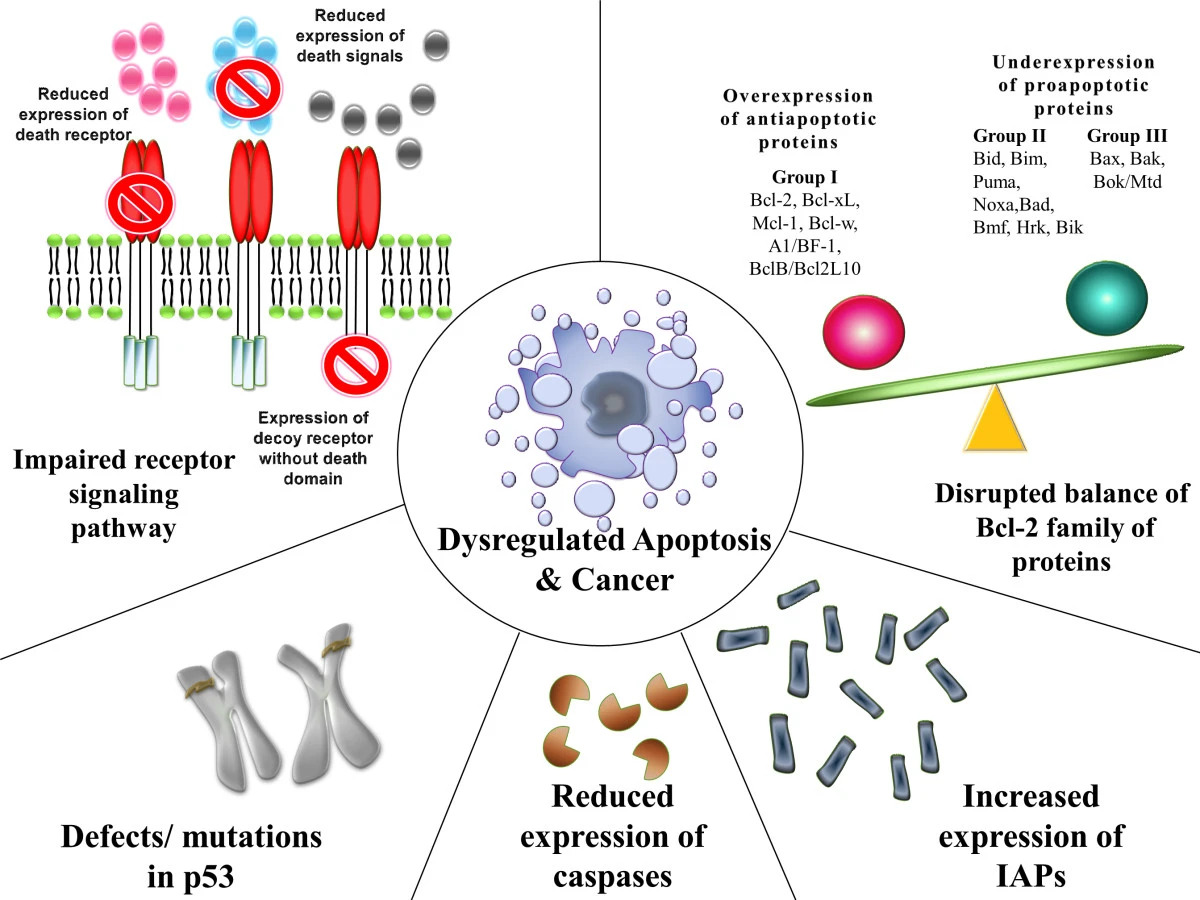Playlist
Show Playlist
Hide Playlist
Apoptosis-related Genes
-
Slides CP Neoplasia Genetic alterations in malignancy.pdf
-
Reference List Pathology.pdf
-
Download Lecture Overview
00:00 Okay, beyond DNA repair, let's talk about apoptosis. So, the mitochondria, as we have spoken about previously is an important regulator of intrinsic apoptosis. You can drive extrinsic apoptosis through cell surface interactions with tumor necrosis factor or cytotoxic T cells. We're talking about the intrinsic pathway that's driven through the mitochondria that's going to be very important for saying "Kill yourself or don't kill yourself." So there are normal proteins. The names of them are not too important, I'm just going to say the abbreviated name, but you can see in the gray box what those names mean. There are normal sentinel proteins that determine whether apoptosis should progress. They will interact with other proteins on the surface of the mitochondria. In particular if I'm going to drive apoptosis, BID and BAD will interact with BAX and BAK and that will engender the formation of a pore. So we have a complex now of BAX and BAK that forms a pore that will allow the release now of cytochrome C that is part of the electron transport chain. That cytochrome C in the cytosol now will drive the assembly and activation of the apoptosome which will then drive caspase activation which will then drive cell death. Okay, so in normal circumstances we have these molecules, BID and BAD, and there are others believe me there are others that are helping the mitochondria to make pore-forming complex that will drive apoptotic cell death if they are turned on. Now turning them on becomes a question. How do we do that? And some of that is driven through upstream things like p53. 01:59 Right? Okay. Now, if we have overexpression. So this apoptotic pathway is tightly regulated. 02:11 We just don't want it willie neely, you know killing cells right and left. So we have other molecules in this case called BCL2 or BCLXL and believe me there are more. But those proteins are counterregulatory. They will prohibit, inhibit, prevent the formation of the pore-forming complex. BCL2, BCLXL are in the mitochondrial membrane and they will interact with BID and BAD and prohibit them or inhibit them from helping to form the pore complex. 02:50 They will also interact with BAX and BAK so we never form the pore complex. That means the more BCL2 we have and the more BCLXL that we have, the more that we will inhibit apoptosis because we won't be forming the pores. I just want to point out that the name for BCL2 is B-cell lymphoma 2. This was actually described originally in a follicular B-cell lymphoma, that's how it got its name. So just kind of hick a step back then if we have overexpression of BAX or BAK or of BID and BAD then we're going to get more pore-forming complex and that overexpression will lead to enhanced apoptosis. It will be functionally acting as a tumor suppressor. On the other hand if we have overexpression of BCL2 or BCLXL as indicated in the green box because of a translocation that allows increased expression of them, then we will turn off the apoptotic pathway and the overexpression will lead to protection from cell death. And so cells who have elevated BCL2 won't die even though they're getting the appropriate signal to die because of the BCL2. And in that case, the BCL2 act like an oncogene. So really, we're talking about things that are being regulated at the level of the mitochondrial death.
About the Lecture
The lecture Apoptosis-related Genes by Richard Mitchell, MD, PhD is from the course Neoplasia.
Included Quiz Questions
What activates the apoptosome?
- Cytochrome c
- Caspase
- Membrane pore complex
- BAX
- BAK
What mutation is associated with BCL?
- t(14;18)
- t(11;14)
- t(11;18)
- t(9;22)
- t(9;12)
Customer reviews
5,0 of 5 stars
| 5 Stars |
|
5 |
| 4 Stars |
|
0 |
| 3 Stars |
|
0 |
| 2 Stars |
|
0 |
| 1 Star |
|
0 |




